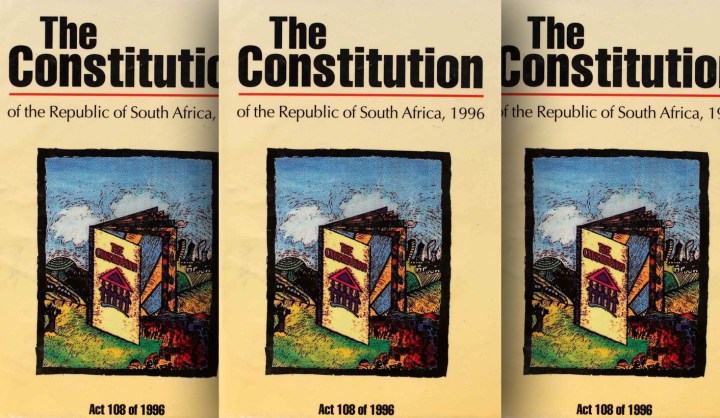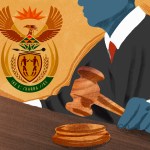Maverick Citizen Analysis
Introducing ‘Our Struggle, Our Freedom, Our Constitution’

I didn’t expect that I would have such a viscerally emotional response to the website, but I did. In almost every photo or video I saw, there was someone who I related to in some way. The songs peppered through the site were so hauntingly evocative they took me to the exact moments in our tempestuous history that they were birthed. This is the source of the archive’s power, its ability to connect with ordinary South Africans.
“Today is a day of joy. It is a day of celebration. It is indeed a historic day. It is the birthday of the South African rainbow nation. This is the day when South Africa is truly born.” It was with these words that on the 8th of May 1996, Cyril Ramaphosa presented the final draft Constitution to parliament and president Nelson Mandela for a vote. It was signed into law by Mandela at the historic commemoration site of the Sharpeville Massacre on 10 December 1996.
Arriving on the website, an online exhibition and archive of our democracy’s journey and history , launching at 8pm on 24 September, you are greeted by the triumphant smiles of 2 presidents, Nelson Mandela and Cyril Ramaphosa raising the Constitution towards the people. It seems apt that Ramaphosa would be somewhat centrally focused in this image as he was instrumental to crafting our country’s road map. The picture lends itself to both past reflection and a reflection on where we are in our Constitutional democracy under the stewardship of both presidents.
As part of its introduction lies this statement which captures the depth on investment that went into breathing life into South Africa’s new supreme law “Few know of the intense battles that took place in the streets and were echoed in the negotiating chamber where sworn enemies sat across from one another; of the fierce debates that shaped specific provisions of the Constitution; and the many behind-the-scenes challenges that had to be overcome to allow a country of despair to become a country of hope.”
The website is divided into nine sections which can be navigated by clicking through the photographic tiles depicting each section. One of the most striking sections is that of the Constitutional Court. This is shown by a photo of judges in their trademark green gowns. The section takes you through the thinking behind moving the court from its original location, the members of the first bench appointed by president Mandela and the court’s architectural significance which is founded on the concept of inclusivity. It also takes you through some of the landmark cases that the court presided over such as the Treatment Action Campaign’s fight for antiretrovirals, The Grootboom case that ruled on the state’s obligation regarding homelessness and the Marriage Equality case granting same sex marriages.
The ‘Negotiating our Freedom’ section spans from the state of emergency in 1985 to democracy in 1994. The title prods and unsettles me. It forces me to reckon with the fact that once upon a time my freedom as a black person had to be ‘negotiated’. My personhood and human rights were not guaranteed, I wonder how many amongst us really appreciate that simple fact. This was a very violent time in South African history and the pivotal moments in the timeline are punctuated by mirroring songs from of Vusi Mahlasela, Tshepo Tshola, Brenda Fassie and the Sarafina cast all decrying the unrest and yearning for Freedom.
One such moment that stands out is the story of Chris Hani, which takes me back to a very dark, scary confusing time. It was a time where pandemonium threatened to engulf South Africa, a year before the negotiated dawn of our democracy. Hani was the charismatic leader of the South African Communist Party and the fearless commander of Umkhonto weSizwe. He was so feared that he was assassinated in his driveway by Janusz Waluś a member of the right wing Conservative Party, an act with erupted South Africa into anger. It was at this moment that Nelson Mandela, president in waiting, took control of quelling the waters pulling the country back from the brink of drowning in its own blood.
The Constitution and me today section is more forward looking and seeks to make the Constitution and the story of our democracy accessible. It features a number of people’s experiences and thoughts on our history. Advocate Tembeka Ngcukaitobi for instance talks about how he would like to see Robert Sobukwe centralised more in discussions of our country’s evolution. Justice Edwin Cameron describes the Constitution as belonging to all South Africans and that it is deeply rooted in the struggle against subjugation. Also contained in this section is a chance for visitors to the site to submit any archival materials of their own to deepen our country’s story and in a sense preserve our collective memory.
The Constitution Hill Trust section shows that the trust is composed of a mix of activists, legal scholars, entrepreneurs and business people. It has people who were key players in our recent history like Cheryl Carolu and Albie Sachs as well as those currently charting our country’s future like Advocate Adila Hassima and Nandos founder Robert Brozin. It also details that the next phase of this museum and archival project is to have a physical manifestation of what is contained on the website at ConHill.
The site contains details that ordinarily would go unknown and undiscovered such as the section called Pioneers of the struggle. I read for the first time of Halton Cheadle, who drafted the bill of rights and Allan Kirkland Soga, who was a founding member of the South African Native National Congress which was the precursor to the African National Congress. I also learnt of the story of Princess Emma Sandile who is the first recorded female land owner. Theresa Edlmann, a research associate, in the Department of History, Stellenbosch University had this to say about Sandile “Women who transgress social norms and transcend the constraints of their context are hugely deserving of public honour and acknowledgement. Princess Emma – Ukuzazi is a case in point.”
What I enjoyed about the website is that it felt like I was being reminded of parts of my own story that are infrequently visited and re-examined. As we grow older, how we make sense of the world around us comes into sharper focus as our lenses of understanding change. Our Struggle, Our Freedom, Our Constitution is a good lens through which we can make sense of our South African story. DM/MC




















 Become an Insider
Become an Insider
Comments - Please login in order to comment.